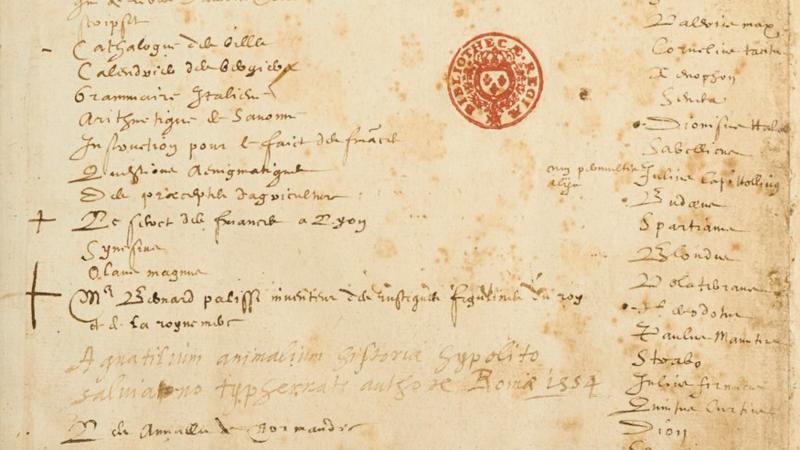A living document on how to juggle these damned things.
Updated March 19, 2025.
What’s a KEM?
A KEM is a Key Encapsulation Mechanism, a cryptographic primitive that has a
KeyGen() algorithm, an Encaps() algorithm, and a Decaps()
algorithm. KeyGen produces a (decaps_key, encaps_key)
keypair. Encaps(encaps_key) uses an encapsulation key (similar to an
asymmetric public key) to compute and return a shared secret and the
encrypted ciphertext encapsulation of that shared secret (often called ct
or enc). Decaps(ct, decaps_key) takes the encapsulated shared secret
ciphertext and the decapsulation key (similar to an asymmetric secret key) to
re-construct the shared secret.
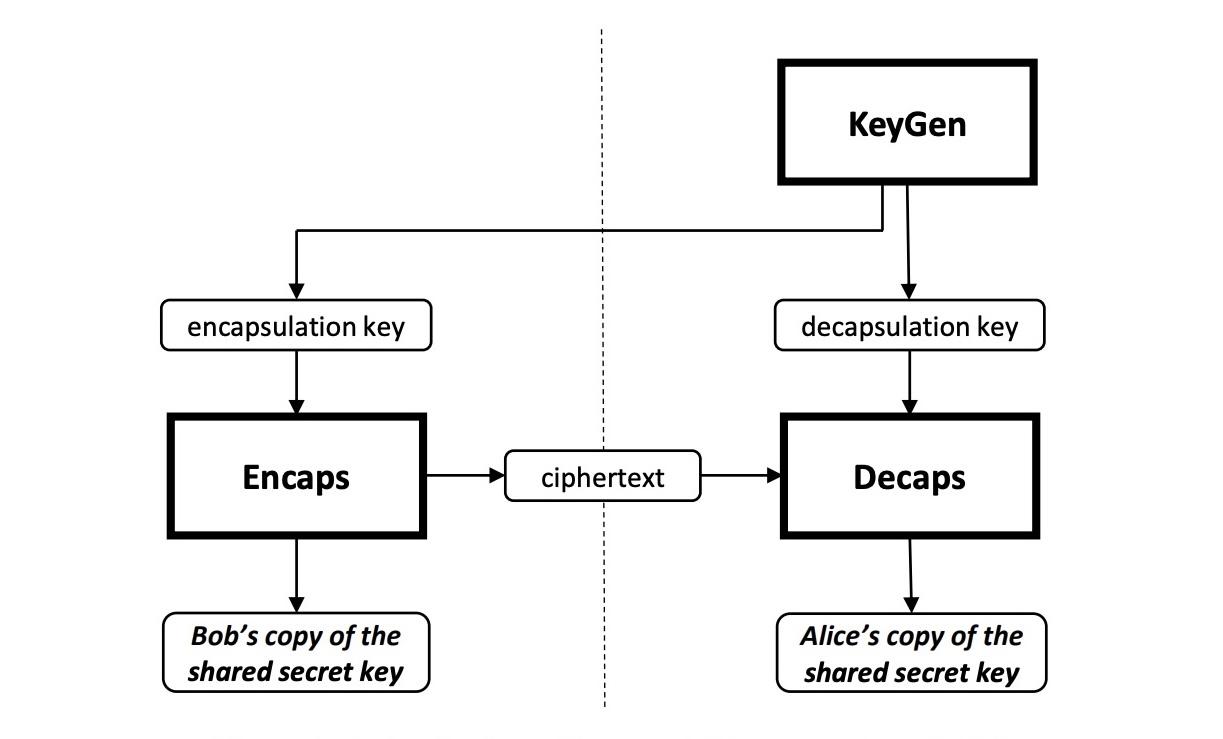 KEM diagram from FIPS 203
KEM diagram from FIPS 203
In general, cryptographic primitives are designed to fulfill a particular
security property when instantiated correctly, and that property is defined
as being able to beat an adversary modeled with certain abilities within a
security game. For digital signatures, there is usually an unforgeability
property under chosen message attack (EUF-CMA); for KEMs, the property is
indistinguishability under chosen ciphertext attack (IND-CCA). Informally
this means that the computed shared secret is indistinguishable from random
against an adversary who can decapsulate maliciously constructed ciphertexts,
but who doesn’t have direct access to the decapsulation key.
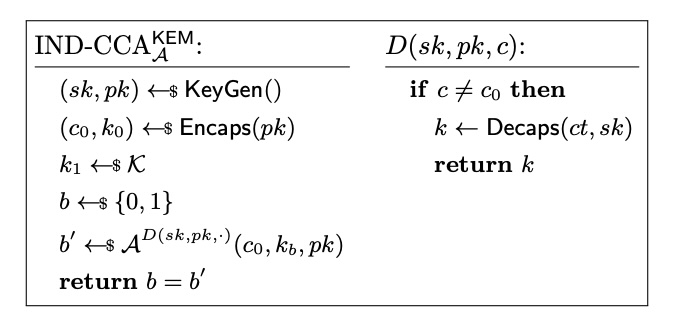 IND-CCA experiment for KEMs, from “Keeping Up with the KEMs”
IND-CCA experiment for KEMs, from “Keeping Up with the KEMs”
KEMs have become ‘all the rage’ recently (not because they are sexy or special, they just seem to be the best we’ve got in a post-quantum world). In the shadow of a cryptographically-relevant quantum computer that can break our Diffie-Hellman’s and elliptic curve-based constructions in ~polynomial time, including stuff that’s been hoovered up and stored for a later day when those quantum computers come online (Store and Decrypt Later), there’s been movement to migrate cryptography protocols off of Diffie-Hellman onto primitives like KEMs, because they enable things like key establishment, but base their security on quantum-resistant problems such as Module Learning-with-Errors.
However. KEMs are not DH, and protocols that were originally designed based
on the properties (formal and informal) of Diffie-Hellman are now trying to
swap them out for KEMs or hybridize them with KEMs. KEMs generally are
designed to fulfill IND-CCA and IND-CCA only, and some designs have been
changed to simplify and make clearer IND-CCA security proofs and to improve
performance, but that also resulted in the removal of some of the other
security properties that make them trickier to just use without caveats.
Re-encapsulation attacks
As coined by Cremers et al and explored by the
Cryspen team, re-encapsulation attacks exploit the fact
that some KEMs allow the decapsulation of a ciphertext to an output key k and
then can produce a second ciphertext for a different public key that
decapsulates to the same k. Re-encapsulation attacks in protocols, often
known as an unknown-key-share attack, result in two parties computing the
same key despite disagreeing on their respective partners. This doesn’t sound
great, but is completely allowed under the IND-CCA security definition! To
avoid these sorts of attacks, we need to know more about a KEM than just that
it’s an IND-CCA-secure KEM: we need to know how it binds its shared secrets
to encapsulation keys and ciphertexts. This is a thing we didn’t need to
think about with Diffie-Hellman, as it was only in weird cases (small-order
points, ‘non-contributory behavior’, etc) that
Diffie-Hellman public keys were not tightly bound to the shared secret
resulting from the computation, and there was no ciphertext to juggle either.
Binding properties
Cremers, Dax, and Medinger formalized these notions of ‘binding’ properties for KEMs and explored their relations to similar notions like ‘robustness’ and ‘contributivity’ in the literature, including describing a spectrum of adversaries with different capabilities, how these notions relate (or imply) each other, and checked them via symbolic analysis with Tamarin. For a value to ‘bind’ another value, such as a shared secret K binding an encapsulation key PK, is to uniquely determine it; more formally, “P binds Q” if, for fixed instances of P, there are no collisions in the instances of Q.
 The generic binding property instantiations X-BIND-P-Q before choosing X ∈ {HON , LEAK, MAL} from “Keeping Up with the KEMs”
The generic binding property instantiations X-BIND-P-Q before choosing X ∈ {HON , LEAK, MAL} from “Keeping Up with the KEMs”
There are different security models of adversaries for these properties:
honest (HON), leak (LEAK), and malicious (MAL). Honest variants involve
everyone behaving themselves, such that the involved key pairs are output by
KeyGen() and not accessible by the adversary, but the adversary has access
to a Decaps() oracle. Leakage variants have honestly-generated key pairs
leaked to the adversary. Finally, in malicious variants, the adversary can
create the key pairs any way they like in addition to the key generation, so
they can do…a lot. Ideally, our KEMs would be resistant to such
adversaries, so these MAL-BIND-P-Q properties are attractive.
 General hierarchy of binding properties for KEMs from “Keeping Up with the KEMs” (NB: implicit rejection KEMs have a restricted hierarchy)
General hierarchy of binding properties for KEMs from “Keeping Up with the KEMs” (NB: implicit rejection KEMs have a restricted hierarchy)
Some of the big takeaways here are that we like MAL-BIND-K-CT and
MAL-BIND-K-PK properties in our KEMs:
-
A
MAL-BIND-K-PK-secure KEM means that the KEM’s shared secret (K) binds to the encapsulation key (PK) used to compute it, even against a malicious adversary that has access to leaked key material and is capable of manufacturing maliciously-generated keypairs. This strong binding to the encapsulation key protects broadly against re-encapsulation attacks because different parties (as identified by their public key) cannot be coerced into deriving the same key. -
A
MAL-BIND-K-CT-secure KEM means that the KEM’s shared secret (K) binds to the encapsulated shared secret ciphertext (CT), even against a malicious adversary that has access to leaked key material and is capable of manufacturing maliciously-generated keypairs. This strong binding to the ciphertext protects broadly against re-encapsulation attacks so that two different ciphertexts cannot decapsulate to the same shared secret K.
Implicit rejection
Digging even deeper, a lot of popular KEMs are implicitly rejecting, as a
result of their particular flavor of applying the Fujisaki-Okamoto (FO)
transform. The FO transform takes a public key encryption (PKE) scheme secure
under chosen-plaintext attack (IND-CPA) and turns it into an IND-CCA KEM
scheme. Implicitly rejecting KEMs always return a value, even if the PKE
decryption step inside Decaps() fails or returns an unexpected value. This
design means that Decaps() always returns a pseudorandom value, even if
decryption fails. This is hopefully safer to use in higher-level protocols
that may or may not check the decapsulation value. Because of
this implicit rejection design, there are fewer binding properties available
to such KEMs, period, and this generally eliminates their ciphertexts alone
binding to public keys or shared secrets: any ciphertext will be accepted,
and these will almost certainly decapsulate to different shared secrets. This
means that implicitly rejecting KEMS cannot be X-BIND-CT-K-secure or
X-BIND-CT-PK-secure for any of the binding adversary variants, and we are
only possibly left with the subset of binding properties below.
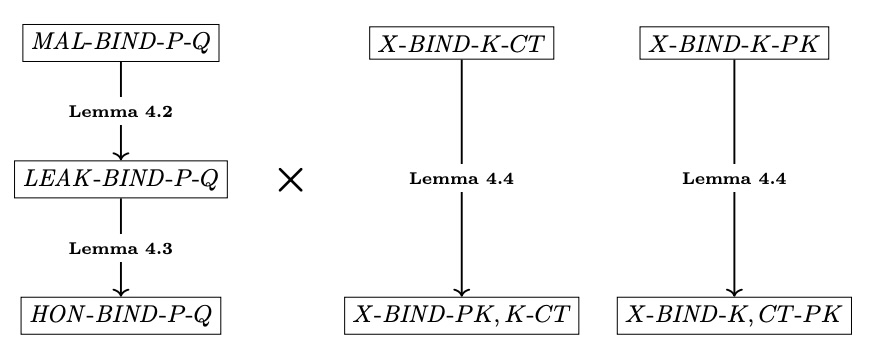 Restricted hierarchy of binding properties for implicitly-rejecting KEMs from “Keeping Up with the KEMs”
Restricted hierarchy of binding properties for implicitly-rejecting KEMs from “Keeping Up with the KEMs”
ML-KEM
Updated September 2024
Per the analysis of the final standard FIPS 203 in Sophie
Schmieg’s “Unbindable Kemmy Schmidt”, a strictly compliant
instantiation of ML-KEM is LEAK-BIND-K-PK-secure
andLEAK-BIND-K-CT-secure, but not MAL-BIND-K-PK-secure nor
MAL-BIND-K-CT-secure (although keep reading for caveats). This means that
the computed shared secret binds to the encapsulation key used to compute it
against a malicious adversary that has access to leaked, honestly-generated
key material but is not capable of manufacturing maliciously generated
keypairs. This binding to the encapsulation key broadly protects against
re-encapsulation attacks but not completely.
This step down from MAL security and vulnerability to the Kemmy
Schmidt attacks is due to the ‘expanded’ key format of ML-KEM
as specified in FIPS 203: the K-PKE PK hash is stored in the
decapsulation key format instead of being re-computed from the K-PKE secret
key. A MAL attacker can replace this K-PKE PK hash to trick the
decapsulator into calculating the same K for a different CT, therefore
violating the MAL-BIND-K-CT and MAL-BIND-K-PK properties. A MAL
attacker can also mess with the z FO-transform rejection value that is
cached in the expanded decapsulation key format, which can be the same as the
z in another key pair, and when the rejection value of K is returned, it
will match another K for different keypair, violating the MAL-BIND-K-PK
property.
Luckily, before the standard was finalized, NIST listened to feedback about
some of these attacks and officially supported storing ML-KEM keys as two
seeds, the K-PKE seed d, and the FO-transform rejection value z:
 FIPS 203 ML-KEM seed format for keys
FIPS 203 ML-KEM seed format for keys
This is functionally one 64-byte value, but according to the standard, this
is not a single 64-byte sampled value, but two 32-byte sampled values that
together make up the decapsulation key seed. Unfortunately, implementing this
format is not required, merely optional; therefore, one may have a
compliant instantiation of ML-KEM according to FIPS 203, which would be only
LEAK-BIND-K-CT-secure, vs another compliant instantiation of ML-KEM, that
only uses the (d, z) decapsulation key seed format, which is
MAL-BIND-K-CT-secure. 🙃
Using ML-KEM keys in this manner in practice protects against the first Kemmy
Schmidt attack above, but it does not protect against the second. It would be
nice to have a single 32-byte seed that
could be expanded in a compliant way into both d and z, but alas NIST
said no. If that were allowed, it would have
mitigated the MAL-BIND-K-CTand MAL-BIND-K-PK Kemmy Schmidt attacks
completely.
The (d, z) seed format is a fully FIPS-compliant way to store and use
ML-KEM, and I recommend using it in practice and plan to do so myself. To get
close to MAL-BIND-K-CT security with this format, the keypair _MUST_be
validated as well-formed via the ‘key pair check’ in section 7.1 - this
regenerates the expanded decapsulation key format and encapsulation key from
the seed format and checks that they match. This does have performance
implications.
ML-KEM is also LEAK-BIND-K,PK-CT-secure (ciphertext collision-resistant,
CCR). This means that the computed shared secret and the
encapsulation key together bind the ciphertext. Since ML-KEM is
MAL-BIND-K-PK-secure, given a shared secret K, we know it uniquely binds to
a PK, and because together K and PK uniquely bind to a CT, that means we get
LEAK-BIND-K-CT for ML-KEM, but not MAL-BIND-K-CT. This is formalized by
corollary A.8 in keeping-up-with-the-kems.
Once upon a time, there was Kyber before it was changed to not hash in the
ciphertext anymore. Kyber, as defined in version 3.02 of the NIST PQC
submission, hashed in the ciphertext into the derivation of the
shared secret and thus was MAL-BIND-K-CT as well as MAL-BIND-K-PK. This
was removed as Kyber transformed into ML-KEM, ostensibly to get the speedup
by avoiding hashing the large ciphertext while also making the IND-CCA proofs
of security simpler because that was the security goal at the time. Alas.
ML-KEM (and Kyber and some others) are implicitly rejecting KEMs. In ML-KEM,
the implicit rejection value is derived from randomness (part of the
decapsulation key) and the ciphertext (which is ostensibly
attacker-controlled). Yes, I am aware of the irony that the ciphertext is
bound by the implicit rejection ‘key’ but not the real shared secret. 💀 This
means that ML-KEM cannot be X-BIND-CT-K-secure or X-BIND-CT-PK-secure for
any of the binding adversary variants, and we are restricted to the smaller
set of binding properties for implicitly rejecting KEMs.
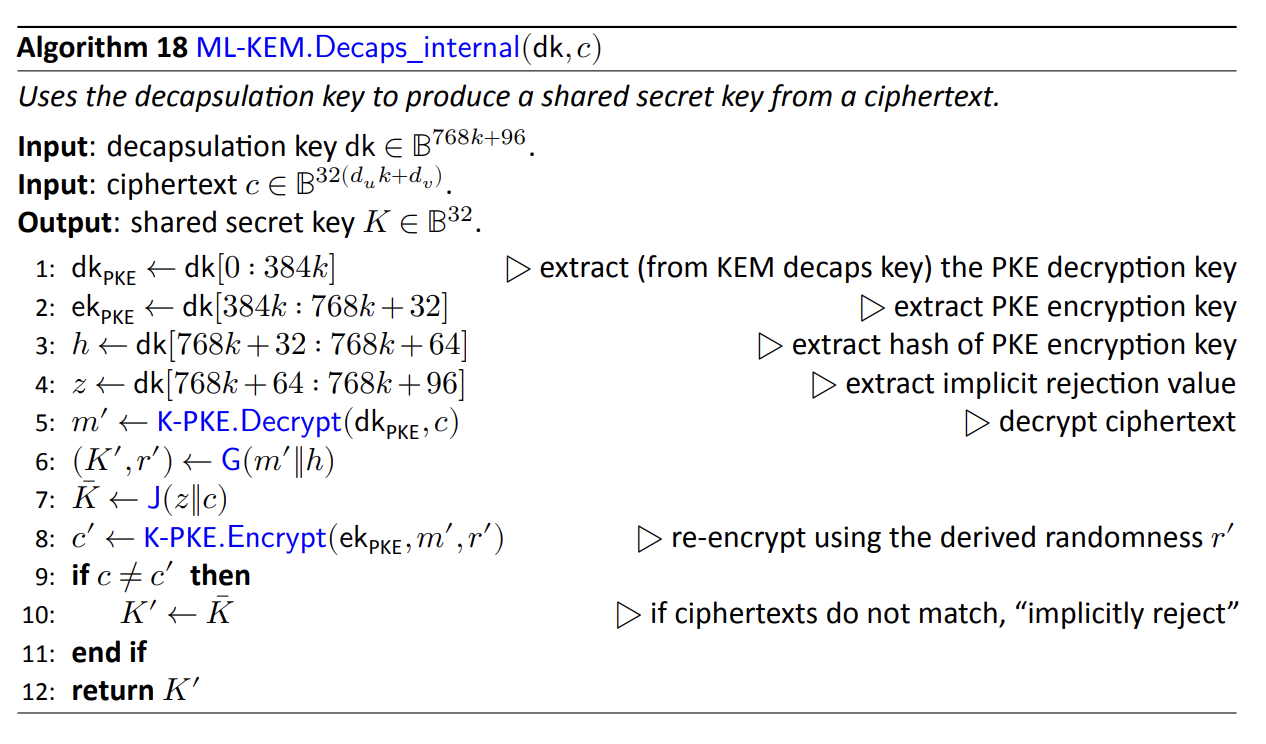 ML-KEM.Decaps_internal from FIPS 203, demonstrating implicit rejection
ML-KEM.Decaps_internal from FIPS 203, demonstrating implicit rejection
So to sum up, straight-up ML-KEM is LEAK-BIND-K-PK, LEAK-BIND-K,CT-PK,
LEAK-BIND-K,PK-CT, and LEAK-BIND-K-CT-secure, but not any flavor of
X-BIND-CT-K or X-BIND-CT-PK-secure. Using the (d, z) format of the
decapsulation keys and validating keypairs mitigates attacks such that
MAL-BIND-K-CT can be achieved…if you don’t fuck it up. 🫠
How do I hold it?
If I’m using ML-KEM in a protocol, in general, because it lacks
MAL-BIND-K-CT and MAL-BIND-K-PK security, I would make sure to commit to
the encapsulated shared secret ciphertext (CT) and encapsulation key (PK)
along with the decapsulated shared secret, either in the final protocol KDF
or something similar. TLS 1.3 commits to basically everything
in the handshake transcript as part of its key schedule, so they are already
doing this ‘for free.’ Apple’s PQ3 upgrade to iMessage includes
the ML-KEM ciphertext and encapsulation key in the label field of the
HKDF-Expand() call in its KDFRKCK KDF function, along with a lot of other
transcript stuff. In general, if you can afford it, I would hash in / commit
to all public data in the protocol transcript, including the encapsulation
keys - It can really save your ass.
Unless you write a security proof showing otherwise, the ML-KEM shared
secret does not bind to the ciphertext nor against adversaries that
maliciously twiddle key material, so I would recommend hashing it into your
KDF or equivalent along with the shared secret. Otherwise, there is a burden
of proof to demonstrate security against MAL adversaries.
To get close to MAL-BIND-K-CT security with the compliant seed format, the keypair MUST_be validated as well-formed - I recommend it. You may be able to skip including the CT in your external KDF if you do. Since MAL-BIND-K-PK is not achievable in a compliant way, I _strongly recommend including the PK (encapsulation key) in your KDF.
Classic McEliece
Classic McEliece is another PQ-secure KEM that is built on code-based cryptography (instead of lattices, like ML-KEM or Kyber). It is a fourth-round candidate in NIST’s PQC KEM competition, a proposed ISO standard, and the general McEliece public-key encryption design has a long and robust history behind it.
Classic McEliece, as specified in the NIST
submission, is MAL-BIND-K-CT-secure and
MAL-BIND-PK,K-CT-secure. This means you can use the shared secret output
without also committing to the encapsulated shared secret ciphertext. But
that’s it. Classic McEliece lacks any binding to the encapsulation key (PK)
in any of the adversary security models, as the underlying public key
encryption scheme allows a ciphertext CT to decrypt to the plaintext message
under any decryption key, not just the decryption key
associated with the public encryption key used to generate the
ciphertext. Since Classic McEliece derives the KEM shared secret only from
the ciphertext CT and the randomness (message), and the underlying PKE allows
us to generate the same shared secret K from multiple ciphertexts for any key
pair, Classic McEliece is not HON-BIND-K-PK or any other variant thereof.
Since Classic McEliece is also an implicitly rejecting KEM, it lacks the
X-BIND-CT-PK and X-BIND-CT-K properties too.
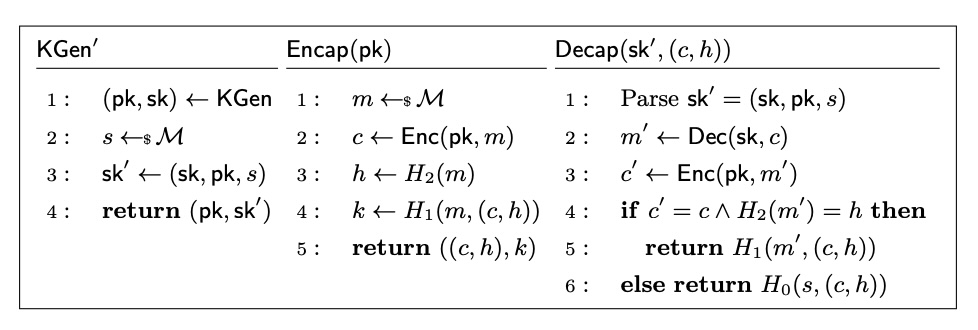 Classic McEliece from Anonymous, Robust Post-Quantum Public Key Encryption
Classic McEliece from Anonymous, Robust Post-Quantum Public Key Encryption
Therefore Classic McEliece is MAL-BIND-K-CT-secure and
MAL-BIND-PK,K-CT-secure, but not any flavor of X-BIND-CT-K,
X-BIND-CT-PK, X-BIND-K-PK, or X-BIND-K,CT-PK -secure.
How do I hold it?
You MUST commit to the Classic McEliece public encapsulation key (PK) as well as the derived shared secret K in your KDF or equivalent. This may be quite annoying as Classic McEliece encapsulation keys are much larger than, say, ML-KEM encapsulation keys, and hashing them or including them as inputs to your KDF may be computationally expensive.
FrodoKEM
FrodoKEM is another implicitly rejecting PQ KEM based on lattices, but it relies on the learning-with-errors problem instead of the module-LWE problem (like ML-KEM and Kyber), and it uses a different flavor of FO-transform to produce a KEM from its underlying FrodoPKE public key encryption scheme. It was a NIST PQC candidate KEM and is a proposed ISO standard.
FrodoKEM hashes in its encapsulation key (PK) and its ciphertext (CT) into
the final internal hashing step that produces the final shared secret
(K). Even without looking at the underlying PKE scheme, we can see it has
MAL-BIND-K-PK, MAL-BIND-K,CT-PK, MAL-BIND-K-CT, and MAL-BIND-PK,K-CT
security. Since it’s an implicitly rejecting KEM, it does not have any
X-BIND-CT-K or X-BIND-CT-PK binding properties. Easy-peasy.
 FrodoKEM FO-transform IND-CCA construction
FrodoKEM FO-transform IND-CCA construction
How do I hold it?
In terms of binding properties, FrodoKEM is pretty great. In general, I still would commit to all the public transcript data in my KDF, along with the shared secret produced by FrodoKEM, but not because the shared secret is not bound to the FrodoKEM encapsulation key or ciphertext but for other protocol security properties.
HQC
HQC (Hamming Quasi-Cyclic) is a structured code-based KEM that NIST has selected as its PQC fourth round finalist. The final FIPS standard is estimated to arrive in about two years.
NIST announced the fourth round for KEMs when they selected ML-KEM, and said they are choosing HQC “because we want to have a backup standard that is based on a different math approach than ML-KEM.”
HQC has tiny secret decapsulation keys (40 bytes), large public encapsulation keys (2.2 KB at minimum), and very large ciphertexts (4.4 KB at minimum), especially compared to ML-KEM:
 HQC keys and ciphertext sizes in bytes
HQC keys and ciphertext sizes in bytes
As we saw in the journey from Kyber to ML-KEM, these numbers, the computational performance, and the exact design of HQC may change slightly before it lands as a standard in ~two years, but let’s look at the fourth round version of HQC for now.
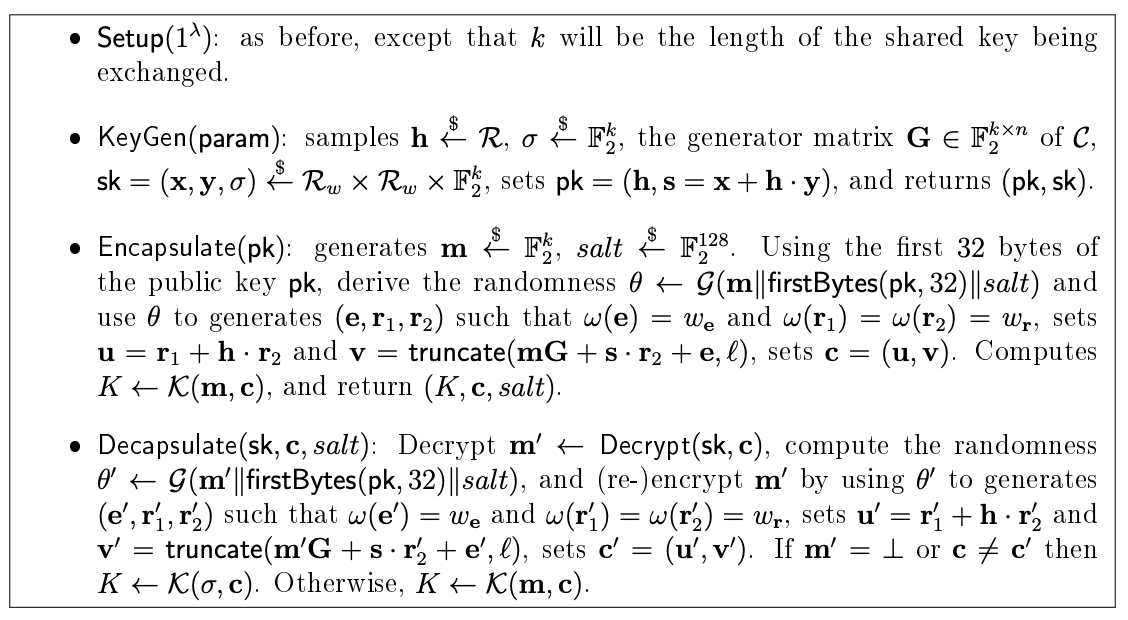 HQC KEM from Round Four Submission
HQC KEM from Round Four Submission
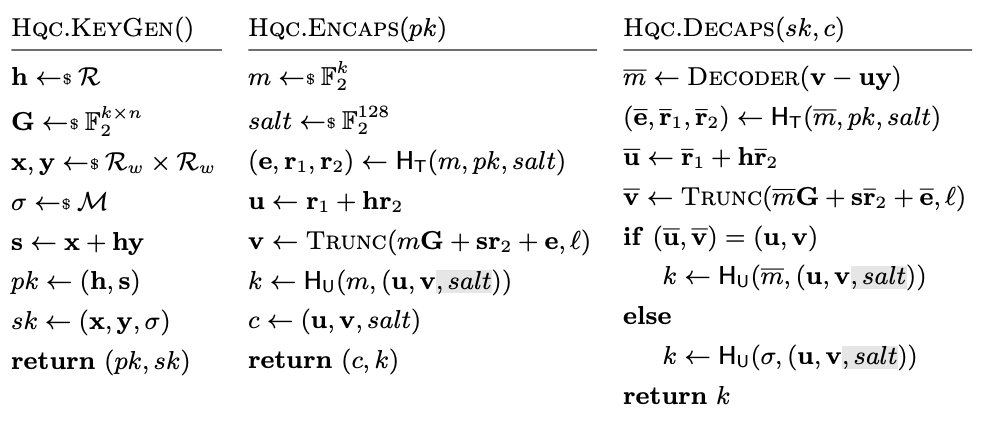 HQC KEM from Kramer, Sctruck, and Weishäupl (the grey is a suggested change, HQC*)
HQC KEM from Kramer, Sctruck, and Weishäupl (the grey is a suggested change, HQC*)
A quick look at the construction shows that HQC applies a variant of the
implicit-rejection FO transform to its public key encryption scheme to
produce an IND-CCA KEM, introducing a random salt to protect against
multi-ciphertext attacks. The salt is appended to the PKE ciphertext, and is
an input to the PKE internal KDF, but it is not part of the KEM key
derivation, and left in the clear appended to the ciphertext and output by
the KEM encapsulation. This is a signal that the shared secret K does not
fully bind the ciphertext CT for HQC.
More formally, HQC’s PKE scheme is non-rigid, allowing two
different honestly-generated keypairs to fail to decrypt with one keypair a
randomly chosen message encrypted by the other keypair with overwhelming
probability. This sounds like a good thing, until you make that
‘random message’ the implicit-rejection value of one KEM keypair and try
decapsulation under another— in the HQC construction, this results in the
same KEM shared secret K even though the PKE scheme rejects the ciphertext
because it is non-rigid. Thus, you can get the same K for different PKs,
making it vulnerable to a LEAK attacker (we did not modify any
honestly-generated keys, we twiddled with what ‘random’ message was being
encrypted). Specifically this means HQC is NOT LEAK-BIND-K,CT-PK-secure,
which implies that it is not
LEAK-BIND-K-PK-secure either.
Relatedly, the public encapsulation key is only computed over by the
underlying HQC PKE scheme, so the particulars of the PKE construction
completely determine if the shared secret K binds the public encapsulation
key PK. If the KEM KDF had included the PK directly in its preimage, this
wouldn’t be the case.
For the ciphertext binding, one can use a similar attack leveraging those
salts to show that the shared secret K does not uniquely bind the
ciphertext CT. If we use another key’s implicit-rejection value as our
‘random’ message for the PKE encryption, and change the random salt value, we
can create a separate invalid ciphertext— since the salt is not used to
derive K, the valid and invalid ciphertexts result in the same key,
violating LEAK-BIND-K-CT security.
Therefore HQC as currently specified in the Round Four submission is not
MAL-BIND-K-PK nor LEAK-BIND-K-PK, nor MAL-BIND-K-CT or
LEAK-BIND-K-PK— it is only HON-BIND-secure across the board. Considering
the sizes of the ciphertexts especially but also the public encapsulation
keys, this isn’t great.
Turns out this intitial analysis missed something, in that if you give HQC
two invalid ciphertexts (as allowed by IND-CCA) that only differ in the salt,
it will produce the same shared secret (by implict-rejection.) This means
that HQC isn’t even HON-BIND-K,PK-CT nor HON-BIND-K-CT secure!
Therefore HQC as currently specified in the Round Four submission is not
MAL-BIND-K-PK nor LEAK-BIND-K-PK, nor MAL-BIND-K-CT or LEAK-BIND-K-CT
or HON-BIND-K-CT: it is only HON-BIND-K-PK-secure, and that’s
it. Considering the sizes of the ciphertexts especially but also the public
encapsulation keys, this isn’t great.
How do I hold it?
Since HQC does not have even LEAK-BIND-K-PK security, the public HQC
encapsulation keys MUST be included in your higher-level
protocol’s KDF or key derivation. Your only protection is that secret
decapsulation keys never leak, for any reason. I would not use HQC in
practice unless I can directly include the public encapsulation keys in my
KDF or key schedule, despite their large sizes.
Because HQC isn’t even HON-BIND-K-CT-secure, the even larger ciphertexts
MUST be included in protocol KDFs or key derivation. HQC
permits everyone to do everything correctly and honestly and the shared
secret will still not bind to the ciphertext. I would not use HQC in practice
unless I can directly include the ciphertexts in my KDF or key schedule,
despite their large sizes.
If there are changes between the round four specification and the final standard maybe this will change.
Updated March 19 2025 for updated HQC round 4 candidate analysis.
